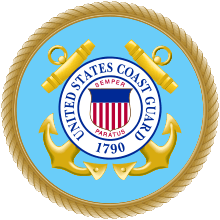Coast Guard Act
The Coast Guard Act of 1915 was passed by Congress on January 20, 1915, and signed into law by then-American president Woodrow Wilson on the twenty-eighth day of the same month. The act created the United States Coast Guard[1] as a new service outwardly modeled on the structure of the U.S. Navy and under the command of the Department of Treasury.
.svg.png) | |
| Other short titles | An Act to create the Coast Guard by combining therein the existing Life-Saving Service and Revenue-Cutter Service. |
|---|---|
| Enacted by | the 63rd United States Congress |
| Effective | January 28, 1915 |
| Citations | |
| Public law | Pub.L. 63–239 |
| Statutes at Large | 38 Stat. 800 |
| Codification | |
| Titles amended | 14 U.S.C.: Coast Guard |
| U.S.C. sections created | 14 U.S.C. ch. 1 § 1 et seq. |
| Legislative history | |
| |
Its men wore uniforms and had the responsibility of protecting American coastal cities and waters from hostile attack, enforcing customs duties and performing search and rescue missions at sea and in coastal environments. The U.S. Coast Guard is a branch of the United States Armed Forces[2] authorized to stop, search and arrest suspected smugglers and other unlawful intruders into American waters.[3]
Mergers
The Coast Guard was created from the merged United States Life-Saving Service and the United States Revenue Cutter Service, which had been established in 1790 to prevent smuggling until the reestablishment of the Navy in 1798.[4]
Although placed under the U.S. Treasury Department the Coast Guard was temporarily transferred to the Navy Department during World War I and again during World War II. In 1939, the Coast Guard also integrated and incorporated the United States Lighthouse Service and, in 1942, the Bureau of Marine Inspection and Navigation. In 1967, the Coast Guard was placed under the United States Department of Transportation.
Further Amendment
Since 2003, the U.S. Coast Guard has fallen under the jurisdiction of the Department of Homeland Security and as before in times of war and emergency when declared by the president it reverts to the navy's control.[5]
References
- "Coast Guard History". USCG. Retrieved 1 December 2012.
- "14 USC 1 - Sec. 1. Establishment of Coast Guard". us-code.vlex.com. Archived from the original on 13 April 2014. Retrieved 1 December 2012.
- "Coast Guard Act Law & Legal Definition". definitions.uslegal.com. Retrieved 1 December 2012.
- "coast guard". education.yahoo.com. Retrieved 1 December 2012.
- "14 USC § 1 - Establishment of Coast Guard". www.law.cornell.edu. Retrieved 1 December 2012.
